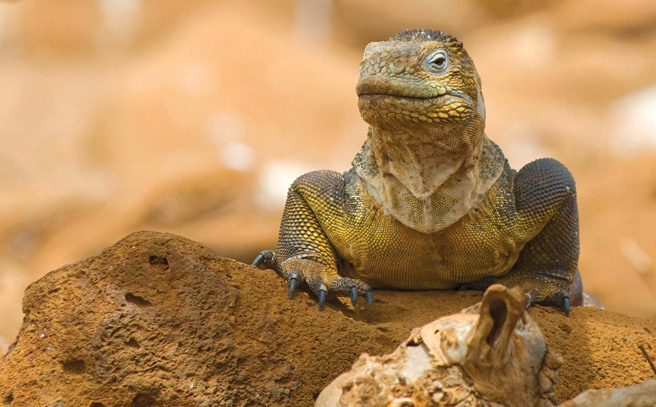
A Galápagos Land Iguana surveys its domain. Photo © Javarman.
The only sea-faring lizards in the world, Galápagos marine iguanas are living proof of evolution. Scientists estimate that this species adapted over two or three million years from their land iguana cousins in order to find food underwater in the form of nutritious coastal seaweed. A flattened snout allows them to press themselves against the rocks to feed, a flattened tail propels them more effectively underwater, long claws grab the rocks firmly, and salt-eliminating glands in the nostrils cleanse the sea salt from their bodies. They can dive more than 12 meters below the surface.
Marine iguanas congregate in colonies for most of the year. During the mating season, which usually corresponds to the rainy season, males become more brightly colored, and their black coloring is punctuated by red, orange, and green spots.
Where to See Marine Iguanas There are sizeable populations of marine iguanas on Seymour Norte, James Bay on Santiago, Gardner Bay and Punta Suárez on Española, and various sites on Isabela. However, the biggest population by far is at Punta Espinosa on Fernandina.The Galápagos has seven subspecies of land iguana. They live in dry areas, and like their marine cousins, newborns are one of the few terrestrial creatures that have to fear the Galápagos hawk. They are also prey for many introduced species until they are big enough to defend themselves. As a result, the land iguana species on Santiago and Baltra are extinct, while those on other islands are endangered. A captive-breeding program at the Darwin Center is working to boost the population.
The Galápagos species are distinctively more yellow than greener mainland iguanas, particularly the subspecies on Santa Fé. There are also hybrids born from mating with marine iguanas. Like their marine cousins, the males can be very territorial, exhibiting brighter colors in the mating season and engaging in head-bashing battles with other males. They are famous for their head-nodding, a threat that can also be employed against humans if they get too close. Note that male iguanas can also whip their tails up if startled, so take care approaching them.
Where to See Land Iguanas The best places to see land iguanas are on Santa Cruz, Seymour Norte, Plaza Sur, and Santa Fé.Excerpted from the first Edition of Moon Galápagos Islands.